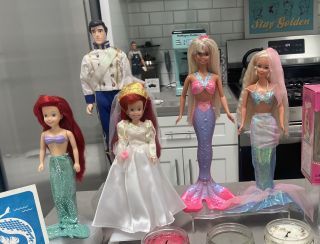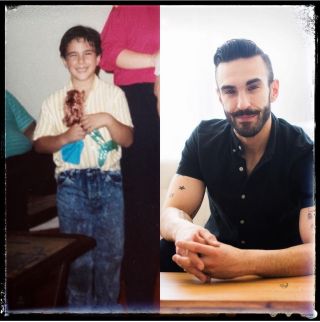Identity
Expressing Queer Identity Through "The Little Mermaid”
The Little Mermaid: A geek therapist’s psychological perspective.
Updated July 1, 2024 Reviewed by Gary Drevitch
.jpg?itok=nPuMj-SC)
I identify as a Latinx, Gender Queer person living with a disability. Those are only some of my intersections, among many others. While it may seem untraditional, my journey toward self-actualization started in 1989 with Tyco’s The Little Mermaid Ariel doll based on Disney’s adaptation. At 4 years old, I knew the ability to transform her fins for feet felt familiar and yet also dissonant. My queer identity was far from a point of reference and cognition, yet in this tale, there was a sense of wholeness for me.
Hans Christian Andersen's fairy tale The Little Mermaid has captivated readers for generations with its themes of love, sacrifice, and identity. Cis-hetero spaces have understood the story through a lens of romance and sacrifice. While that is also true for a queer audience, the narrative reveals intersections and parallels with the concept of queer identity that may be interpreted differently.
Transformation: A Queer Experience
Anderson’s "The Little Mermaid" guides us on a quest by a mermaid princess who tragically falls in love with a human prince and dreams of becoming human herself to be with him. She eventually undergoes a painful transformation by exchanging her voice for legs in a deal with a queer-coded sea witch. The ability to exchange her voice, a metaphor for her opinions and sense of self, mirrors the internal struggle of many individuals navigating their gender or sexual identity. Queer people often feel compelled to trade aspects of their intersectionality for passing privilege or relief from being silenced—all in an effort to change aspects of themselves to fit societal norms.
Rising Above the Waves of Straight Conformity
In the depths of the sea of Anderson’s tale, we find longing, transformation, grief, and self-acceptance—incredibly poignant themes for queer populations. At the onset of sacrifice, the mermaid’s internal desire to find belonging and acceptance in the human world directly reflect Anderson’s own queer experience, as well as a universal yearning for acceptance and self-actualization.
Most people share a desire for connection and intimacy. For queer individuals, this experience can be fraught with nuanced challenges—navigating societal expectations, cisgender (straight) heterosexual normativity, and self-actualization. The mermaid's sacrifice of her voice symbolizes the silencing and erasure often experienced by queer individuals. The transition from mermaid to human can metaphorically reflect trans and queer people who may feel pressured to conform to societal expectations, or transition towards an acknowledgement of their lived experience, despite being told who they are from external messaging. I certainly experience this often in my clinical practice. I’d be lying if I didn’t say countertransference on subconscious internalized queer-phobia doesn’t happen. If often does, and I often think about this story and my own nuanced queer understanding through the mermaid’s sacrifice.

Psychological Impacts of a Mermaid’s Sacrifice
The Little Mermaid lends us a pathway toward understanding or exploring the complexities of identity development. Queer individuals often experience a journey of self-discovery, internal reckoning, and negotiation with societal expectations similar to the mermaid's transformation in exchange for her voice, or, metaphorically, her vocalization of marginalization under the “waves” of conformity. Anderson revels in the psychological toll of concealing or altering one's identity to gain acceptance—which, as we know, can have critical imbalances and negative mental health considerations of queer and trans people.
Disney's animated film, Toie Animation’s 1975 animated film, and subsequent interpretations of the story acknowledge themes of resilience, grit, and self-acceptance, resonating deeply with audiences exploring their own identities. While the original tale is bittersweet and reflective of the painful experiences of marginalized communities, the mermaid's journey encourages us to find our voice, to keep it if possible, and to embrace authenticity. We don’t have to meet the mermaid’s tragic ending; we can challenge conventional norms, fostering a more inclusive understanding of diverse identities within ourselves. This is the turning point in therapy when patients reflect on this narrative, and I often ask, "If the mermaid sacrificed herself for love, how can we honor your lived experience in not only loving yourself, but in allowing an opposite experience where you don’t have to sacrifice your well-being to be loved by others?” I’m sure Anderson may have wanted to hear this very question. In its absence, maybe this is why his tale has lived on through generations and cultures worldwide. It’s a shared human experience: searching for acceptance, love, and authenticity.
What Can We Learn From Losing Our Voice?
The Little Mermaid will always challenge us to find a sense of our identity and to understand the tradeoff of sacrifice. The story asks LGBTQIA+ people to contemplate the many intersections of our queer identity. It gifts us with considerations into the psychological journey of self-discovery, acceptance, and a universal yearning for love in the face of adversity. By examining The the story through a queer vernacular, we gain a deeper appreciation of its relevance in understanding the diverse and evolving nature of human identity.
Anderson couldn’t have known The Little Mermaid would transcend its fairy-tale origins to become a critical metaphor for the universal quest for self-actualization, belonging, and accessibility—or that it would resonate with LGBTQIA+ individuals striving to live authentically in a world that often demands conformity.

As I look at a picture of my younger self, grasping Tyco’s Ariel doll, loving the story of her radical quest and curiosity, I find myself smiling. You see, material culture is a magical thing: She is proudly displayed from time to time in my office, kitchen, or home. As a geek therapist and queer individual as well, I continue to find my voice without sacrificing my identify, or those of my clients. In the end, aren't these the core asks of the therapeutic experience: understanding, resilience, and a quest for connection? I believe so.




